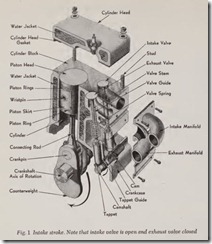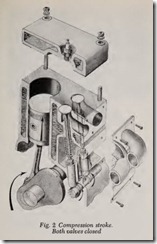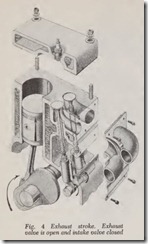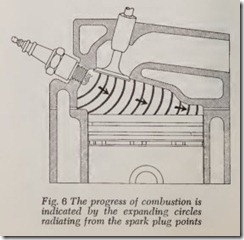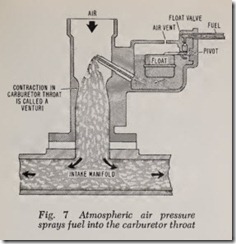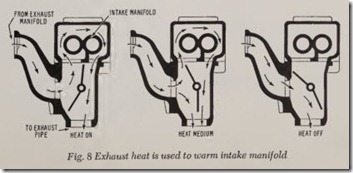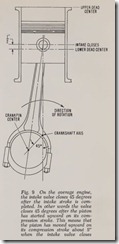ENGINE OPERATION
All engines used in American passenger cars oper ate on the four-stroke cycle principle. This means the engine requires four piston strokes (two up and two down) to complete the operating cycle. Thus, during one half of its operation the four ( stroke) cycle engine functions merely as an air pump . The names of the strokes of the operating cycle are as follows:
1. Intake (pump in) stroke.
2. Compression stroke.
3. Power stroke.
4. Exhaust (pump out) stroke.
Intake Stroke
On the intake stroke, Fig. 1, the piston moves d own, allowing a mixture of gasoline and air to flow into the cylinder through the intake valve, filling the space vacated by the piston. The fuel air mixture is produced in the carburetor and then flows through the intake manifold through the open intake valve into the cylinder. The exhaust valve is closed during the intake stroke.
Compression Stroke
On the compression stroke, Fig. 2, both the intake and exhaust valves are closed. The piston moves up to compress the mixture upwards of 110 lbs. per sq. in. (psi). In order to produce this pressure, the throttle valve must be wide open. The exact pressure depends principally on the compression ratio of the engine. The spark occurs near the end of the compression stroke, igniting the mixture.
Power Stroke
On the power stroke, Fig. 3, both intake and exhaust valves are closed. Combustion pressure may reach about 600 psi on open throttle shortly after the piston starts down at the beginning of the stroke.
Exhaust Stroke
Just before the piston reaches the lower end of the power stroke the exhaust valve opens, Fig. 4.
The pressure in the cylinder at this time causes the exhaust gas to rush into the exhaust manifold at high speed. Most of the gas which remains is pushed out of the cylinder by the upward motion of the piston on its exhaust stroke.
When the piston comes to a momentary stop at the top of the exhaust stroke, the exhaust gases are moving so fast in the exhaust manifold that their inertia helps remove any remaining gas in the combustion chamber. However, a small amount of gas always remains and mixes with the incoming mixture when the intake valve opens. In explana tion, it should be realized that in order to evacu ate all the gas there would have to be no clearance whatever between the piston and cylinder head.
Obviously, each up and down piston stroke requires one-half revolution of the crankshaft. Therefore, one combustion cycle requires four one half revolutions or a total of two revolutions.
COMBUSTION
Power in an automobile engine is produced by the combustion of a mixture of gasoline and air within the cylinders. The mixture is set afire by an electric spark which j umps or flows across a gap between the two electrodes of the spark plug, Fig. 5.
From the spark, which initiates combustion, the flame spreads progressively in all directions throughout the combustion chamber, Fig. 6, until all the mixture is consumed. The combustion pro cess requires approximately 3/1000 of a second. It is often called an explosion although it is a very slow one compared with gun powder or dyna mite-the latter explodes in 1/50,000 of a second. Pound for pound, gasoline contains m ore energy than dynamite.
The materials involved in combustion include the oxygen in the air and hydrogen and carbon which are the two ingredients in gasoline. Com bustion takes place in the combustion chamber. Part of this chamber is formed in the cylinder head, the remaining part is the movable piston. Combustion can be referred to as a chemical marriage: The hydrogen in the gasoline is mated with oxygen to form steam. The carbon in the gasoline is also mated with the oxygen. This mar riage results mostly in the production of carbon dioxide gas (which forms the bubbles in sparkling water). However, a small amount of the carbon is mated with insufficient oxygen and forms carbon monoxide which is a poisonous gas.
FEEDING THE ENGINE
In describing the operation of an automobile engine it is customary to say that the mixture is sucked into the open intake valve while the piston moves down on its intake stroke.
In order to explain what actually happens, bear in mind that the atmospheric pressure at sea level is 14.7 psi. Therefore, when the piston moves down on its intake stroke, the air pressure pushes the mixture through the carburetor and through the intake manifold into a space vacated by the downward motion of the piston.
This air pressure not only pushes air through the carburetor throat into the cylinder but the same pressure sprays the fuel in the carburetor into the air passing through the carburetor throat, Fig. 7.
The contraction in the throat of the carburetor, as shown in Fig. 7, results in a reduction in pres sure which means that the pressure in the throat is always less than one atmosphere ( 14.7 psi at sea level). On the other hand, the pressure acting on the surface of the fuel in the float bowl is always one atmosphere. It should be obvious that fuel must flow through the jet from the higher pressure in the bowl to the lower pressure in the throat.
HEATING THE MIXTURE
The evaporation of the fuel in the carburetor and intake manifold absorbs heat from the air, thereby reducing mixture temperature somewhat. Unfortunately, the air does not contain sufficient heat to evaporate the fuel completely. Therefor,e exhaust heat is applied to the intake manifold, Fig. 8, in order to warm the air enough to cause fairly complete evaporation. Evaporation of the remaining fuel droplets continues as the mixture passes through the intake manifold into the cylin der. Evaporation of most droplets still remaining occurs during the compression stroke. It should be noted, however, that any unevaporated fuel that exists when combustion takes place is wasted be cause the fuel must be a gas to explode.
Poisonous carbon monoxide gas in the exhaust is due either to not enough air in the mixture or to less than a thorough mixing of the air and fuel.
The manifold heater, Fig. 8, raises the temperature of the mixture. The heater is equipped with a thermostatically controlled valve which permits maximum exhaust heat to be applied to the mix ture when the engine is cold and minimum heat when th e exhaust manifold is completely warm. The valve, which is controlled by a thermostatic spring (not shown), is fully closed with a cald engine and fully open when the engine reaches normal operating temperature.
Although the basic principle of manifold heat ing for both In-Line and V-type engines is the same, differences in design make it necessary to alter the construction of heat control components to suit V-type engines.
A typical example would be one with the heat control located in the right-hand exhaust mani fold. When the engine is cold and th e thermostat closes the valve, the resulting back pressure in the
manifold forces the exhaust gas through a cross over passage in the intake manifold to the left hand exhaust manifold. As the engine warms up and the thermostat releases the valve, the flow of hot gas through the crossover chamber is reduced, permitting the exhaust gas to flow through both exhaust manifolds. This explains why the exhaust comes out of only one muffler tail pipe when the engine is cold on cars with dual exhaust systems.
VALVE TIMING
In order to obtain maximum power, the intake and exhaust valves do not open and close exactly at the dead center positions of the piston. The time of opening and closing varies with different makes and models of engines but the average is about as follows:
Intake valve opens 7 degrees before top dead center and closes 45 degrees after bottom dead center on the compression stroke, Fig. 9. Exhaust valve opens 50 degrees before bottom dead center on the power stroke, remains open during the exhaust stroke and closes 9 degrees after top dead center on the intake stroke. Therefore, on the average, the intake valve opens 16 degrees before the exhaust valve closes. This is called valve overlap.
One reason for opening the valves earlier and closing them later is because it takes time to open or close a valve. However, an even more impor tant reason is the effect of gas inertia. At maxi mum engine power the mixture flowing through the intake manifold may reach a speed of 150 mph or more. Therefore, the mixture has a considerable ramming effect and in consequence a much greater weight of mixture can be crammed into the cylinder when the closing of the intake valve is delayed a reasonable amount, such as 45 degrees. This delay means that the piston has moved about Jf inch upward on its compression stroke before the valve closes.
Similarly, in order to evacuate the burned gases from the cylinder without delay the exhaust valve is opened toward the end of the power stroke, or at about 50 degrees before bottom dead center on the average.
Delaying the closing of the exhaust valve to an average of 9 degrees enables the inertia of the exhaust gases to more completely evacuate the cylinder. Likewise, opening the intake valve an average of 7 degrees before the intake stroke begins, gives the valve a head start in admitting the mixture to the cylinder.
Valve timing in any engine is a compromise between low and high-speed operation. An early intake valve closing is favorable to power at low speeds whereas a later closing of the intake valve assists power production at high engine speed. Likewise late opening of the exhaust valve helps power at low speed whereas earlier opening of the exhaust valve improves power at top speed.
